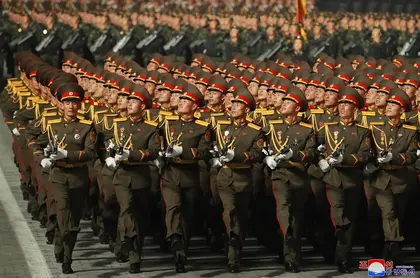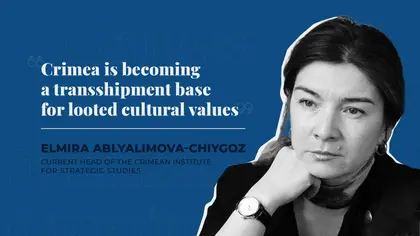The former head of a cultural reserve housing a famous palace has said that the Russian authorities in Crimea are continuing to denigrate the statehood of Crimean Tatars by destroying cultural artifacts. Speaking in an interview with Kyiv Post, Elmira Ablyalimova-Chiygoz, current head of the Crimean Institute for Strategic Studies, said that the Khan’s Palace, which became home to a succession of Crimean Khans from the 16th century, continues to be destroyed through intentionally ruinous rebuilding works. She also underlined that Crimea has become a temporary location for art looted recently by Russians from nearby Kherson Region en route to Russia.
Why is the Khan's Palace in Bakhchysaray so important for the Crimean Tatar people?
Every nation has its own monuments, which are evidence of their ethnogenesis and statehood.
For example, for Ukraine the first constitution written by Pylyp Orlyk is the core of Ukrainian statehood.
Unfortunately, we, Crimean Tatars, don’t have many such things – they are either lost, or stolen, or are situated in other museums.
Yes, of course, there are certain things, ethnographic sources, but this does not demonstrate our statehood.
The Khan's Palace, which was not just a home for the Khan and his family, became a symbol of statehood for us.
It carried out administrative and political functions: important state decisions were adopted, ambassadors from all over the world were received there. This is the anchor that proves that Crimea is our Motherland.

‘Preventing a Bigger War’ – Ukraine at War Update for Oct. 14
Yes, it is not authentic, it was rebuilt immediately after the first annexation of Crimea by the Russian Empire in 1783.
As a result, most of the buildings of the Harem were destroyed, the Winter Palace, the buildings of the Persian courtyard and the cascade garden, which created a special atmosphere in the palace, were ruined.
Russia systematically placed its symbols on the territory of the palace. For example, Alexander's Fountain appeared there. The palace was rebuilt before the arrival of Catherine the Great, the empress of Russia, then before the arrival of other delegations, it was repaired, the paintings on the walls were painted over... But it is important to us even in this condition!
It was miraculously preserved after the deportation of Crimean Tatars in 1944, when everything connected to Crimean Tatar culture was destroyed.
But the head of the Khan's Palace, Maria Kustova, was able to save it with the help of Alexander Pushkin's poem The Fountain of Bakhchysaray.
Do you know what is happening with the palace right now?
Russia says it is carrying out restoration works on its territory. But in reality, the aim of construction works taking place there is to destroy the monument.
I recently receiving photos that show the critical situation at the site. Restoration works are being carried out on all the objects located there, and the appearance of the palace complex is being changed completely.
Only stones remain from the wall of the embassy courtyard. They have begun to "restore" the minarets.
I think the situation is so critical that they’re trying to cover up the real condition within the palace by imitating serious activity. The kitchen building of the palace has fallen into ruin.
Works have begun in the oldest building - the Great Khan Mosque, whose roof really does need to be restored. A certain very small part of the beams that support the roof of the mosque needed restoration and reinforcement.
But the builders, together with Russian occupation authorities, made the decision to completely dismantle the roof and build it from scratch using modern methods and materials.
For some people this may seem like a good decision as the roof really did need to be repaired.
But instead of restoring some parts of it, they continue to completely demolish it. And they do it in a barbaric way, using heavy construction equipment, cranes and jackhammers, without carrying out a proper examination of the building.
They replace hand-made roof tiles with old stamps inscribed on them with Spanish factory-made ones, which imitate the old style, use aerated concrete and a steel framework.
All of this has created an additional load on the ancient walls, and cracks began to appear and paintings were damaged.
It is worth noting that the Khan's Palace is built in such a way that all the buildings are interconnected. When one building sinks, it affects the entire complex.
These actions are a violation of norms of international humanitarian law in terms of the inadmissibility of changing an object of cultural heritage, which can lead to the loss of its artistic, historical, and scientific value.
Why did the Russians undertake to "restore" the Khan's Palace?
I thought about this for a long time. But after listening to some of Putin's speeches, I understood that this is a deliberate policy.
Historical facts must be brought into line with the well-known [Russian] thesis of "Crimea is ours."
And what undermines this thesis? Only the history of Crimean Tatars and the history of our statehood.
Because when we mention the Crimean Khanate, how can Russia talk about "our Crimea"?
Therefore, now they want to turn the monument of our statehood into a monument, whose historical value can be questioned in the future, and then into an ordinary building, completely destroying its historical value.
As a result, the Crimean Khanate will no longer exist.
What about Crimean Tatars?
If they do not leave Crimea under the pressure of repression, they can be called simply Tatars, and then a myth can be created that they are part of the Tatar people living in the Republic of Tatarstan, which is part of the Russian Federation.
Therefore, if we want to destroy the Russian narrative that "Crimea is ours," we need to start with reinterpreting the history of Crimea since 1783.
Tell us about the scandalous construction of the Tavrida Highway by the Russians. What is this project about?
The building of the Tavrida Highway began immediately after the occupation of Crimea. Russia promoted and presented this project as a "highway of life."
But today we see the real purpose of its construction - its use for military purposes. Any construction is accompanied by archaeological research.
These archaeological works are huge in scale, and I think they had catastrophic consequences for our culture.
Crimean archeology is very distinct, it is multi-layered.
Russian archaeologists who worked in Crimea do not understand the distinctive features of these monuments and their value, they’re not excavating the entire monument.
Then developers come and erect buildings on the site, leaving no opportunity for us to dig more in the future. This is a big problem.
But an even bigger problem is that we do not have information about what was discovered and where the artifacts are.
Out of the 100 archaeological studies that we recorded during the construction of the Tavrida Highway, just three mounds were recognized as objects of historical interest.
Which crimes carried out against Crimean Tatar culture committed by Russia have already been recorded in Crimea?
They include the appropriation of immovable and movable cultural objects, illegal archaeological works, the transfer of museum exhibits from the territory of Crimea to Russia, works that led to monuments losing their authenticity.
We’ve been recording the committing of such violations within the auspices of the Crimean Institute for Strategic Studies since 2017.
We have so far recorded 28 facts of the theft of cultural items, 114 illegal archaeological excavations and 10 cases of work, which led to partial loss of the authenticity of items of cultural heritage.
Unfortunately, the figures are rising.
Our project is supported by the International Renaissance Foundation and grant funds.
Our team is not large, but we carefully record everything that happens with the cultural heritage of Crimea.
What can you say about the condition of Crimea's cultural heritage?
We see that Crimea is now becoming a transshipment base for cultural values looted from those territories occupied since February 2022.
We have evidence that the paintings stolen from the Kherson Art Museum are located in the Central Museum of Tavrida on the territory of Crimea.
Also, the General Staff of the Armed Forces of Ukraine reported recently that the Russian occupying authorities of Crimea approved a plan to evacuate museum collections, which does not comply with the provisions of international law.
Unfortunately, if the exhibits are taken, the fate of these artifacts could be a very sad one. If they get to the territory of Russia, we will have to go through a long process to get them back, and it will not take place immediately after [Ukraine’s] victory.
We also record the appropriation of movable and immovable objects of cultural heritage, illegal archaeological excavations and so-called restoration works, which have affected the authenticity of monuments.
Does the Ukrainian Ministry of Culture respond to these crimes?
The issue of protecting cultural heritage objects in occupied territories was not among the priorities of [Ukrainian] state policy until 2022.
It was dealt with from time to time, as a response to certain events.
For example, our organization and various initiative groups have been writing and talking about the need to include sites of cultural heritage in Crimea in state registers of Ukraine since 2017.
But in 2021, just 182 out of 12,000 facilities had been registered.
We see certain positive changes starting in 2022. The Ministry of Culture and Information Policy began to monitor and record the destruction of cultural heritage objects.
The group working on documentation this is professional, and the data collected on the website is informative. But it does not include Crimea!
These violations must be documented because only by combining these two aspects will we received sufficient grounds for preparing a case on genocide.
I'd like to note a very proactive path in work with the Ukrainian Foreign Ministry.
A very important event took place recently - UNESCO representative Chiara Bardeschi began her work in Ukraine [as the Kyiv-based Liaison Officer].
We had waited for this for five years. We hope it will promote positive changes in the work of everyone who deals with the issue of cultural heritage both at state and non-state level.
What should be done to preserve our history for posterity?
It’s very important for Ukraine to build an effective system for the protection of cultural assets, which will operate not only in wartime.
We need to put the registers in order, inventory the objects, review the funding of museums. And if we want to preserve cultural values, we should think about repositories.
We must have a clearly worded cultural policy that will outline certain strategies for our actions in future.
It seems that now is not the right time for all, but as Yevhen Synytsya, head of the Association of Archaeologists of Ukraine, said, "Culture must be beyond the realms of time."
What’s the current mood of Crimean Tatars in Crimea?
I definitely know that they’re waiting for Ukraine. Have you seen the video from liberated Kherson?
Everyone’s rejoicing and crying out of happiness.
These are people who had been under occupation for several months.
And imagine what people who have been under occupation for nine years feel.
They have not forgotten Ukraine, they are just waiting for it.
And I'm waiting for it! My dearest wish is to go back home. I hope it will come true soon.
You can also highlight the text and press Ctrl + Enter






